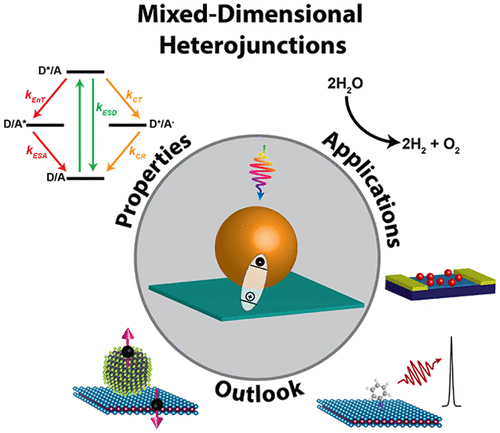当前位置:
X-MOL 学术
›
Acc. Chem. Res.
›
论文详情
Our official English website, www.x-mol.net, welcomes your
feedback! (Note: you will need to create a separate account there.)
Emergent Optoelectronic Properties of Mixed-Dimensional Heterojunctions.
Accounts of Chemical Research ( IF 16.4 ) Pub Date : 2020-01-21 , DOI: 10.1021/acs.accounts.9b00581 Suyog Padgaonkar , Jack N Olding , Lincoln J Lauhon , Mark C Hersam , Emily A Weiss
Accounts of Chemical Research ( IF 16.4 ) Pub Date : 2020-01-21 , DOI: 10.1021/acs.accounts.9b00581 Suyog Padgaonkar , Jack N Olding , Lincoln J Lauhon , Mark C Hersam , Emily A Weiss

|
ConspectusThe electronic dimensionality of a material is defined by the number of spatial degrees of confinement of its electronic wave function. Low-dimensional semiconductor nanomaterials with at least one degree of spatial confinement have optoelectronic properties that are tunable with size and environment (dielectric and chemical) and are of particular interest for optoelectronic applications such as light detection, light harvesting, and photocatalysis. By combining nanomaterials of differing dimensionalities, mixed-dimensional heterojunctions (MDHJs) exploit the desirable characteristics of their components. For example, the strong optical absorption of zero-dimensional (0D) materials combined with the high charge carrier mobilities of two-dimensional (2D) materials widens the spectral response and enhances the responsivity of mixed-dimensional photodetectors, which has implications for ultrathin, flexible optoelectronic devices. MDHJs are highly sensitive to (i) interfacial chemistry because of large surface area-to-volume ratios and (ii) electric fields, which are incompletely screened because of the ultrathin nature of MDHJs. This sensitivity presents opportunities for control of physical phenomena in MDHJs through chemical modification, optical excitation, externally applied electric fields, and other environmental parameters. Since this fast-moving research area is beginning to pose and answer fundamental questions that underlie the fundamental optoelectronic behavior of MDHJs, it is an opportune time to assess progress and suggest future directions in this field.In this Account, we first outline the characteristic properties, advantages, and challenges for low-dimensional materials, many of which arise as a result of quantum confinement effects. The optoelectronic properties and performance of MDHJs are primarily determined by dynamics of excitons and charge carriers at their interfaces, where these particles tunnel, trap, scatter, and/or recombine on the time scales of tens of femtoseconds to hundreds of nanoseconds. We discuss several photophysical phenomena that deviate from those observed in bulk heterojunctions, as well as factors that can be used to vary, probe, and ultimately control the behavior of excitons and charge carriers in MDHJ systems. We then discuss optoelectronic applications of MDHJs, namely, photodetectors, photovoltaics, and photocatalysts, and identify current performance limits compared to state-of-the-art benchmarks. Finally, we suggest strategies to extend the current understanding of dynamics in MDHJs toward the realization of stimuli-driven responses, particularly with respect to exciton delocalization, quantum emission, interfacial morphology, responsivity to external stimuli, spin selectivity, and usage of chemically reactive materials.
中文翻译:

混合尺寸异质结的新兴光电特性。
概观材料的电子维数由其电子波函数的空间局限度定义。具有至少一个空间限制度的低维半导体纳米材料具有随尺寸和环境(介电和化学)可调的光电特性,并且对于光电应用(例如光检测,光收集和光催化)特别感兴趣。通过组合不同尺寸的纳米材料,混合尺寸异质结(MDHJ)可以利用其成分的理想特性。例如,零维(0D)材料的强光吸收能力与二维(2D)材料的高电荷载流子迁移率相结合,拓宽了光谱响应并增强了混合尺寸光电探测器的响应能力,这对于超薄,柔性光电器件具有重要意义。MDHJs对(i)界面化学非常敏感,因为表面积与体积之比大,并且(ii)电场由于MDHJs的超薄特性而无法完全筛选。这种敏感性为通过化学修饰,光激发,外部施加的电场和其他环境参数控制MDHJ中的物理现象提供了机会。由于这个快速发展的研究领域开始提出并回答构成MDHJ基本光电行为基础的基本问题,因此现在是评估该领域的进展并提出未来方向的合适时机。低尺寸材料的优势,挑战和挑战,其中许多是量子限制效应的结果。MDHJ的光电特性和性能主要由激子和电荷载流子在其界面处的动力学决定,这些粒子在数十飞秒到数百纳秒的时间尺度上隧穿,俘获,散射和/或复合。我们讨论了几种不同于本体异质结中观察到的光物理现象,以及可用于改变,探测,并最终控制MDHJ系统中激子和载流子的行为。然后,我们讨论MDHJ的光电应用,即光电探测器,光电器件和光催化剂,并确定与最新基准相比当前的性能极限。最后,我们提出了一些策略,以扩展对MDHJ动力学的当前理解,以实现刺激驱动的响应,特别是在激子离域,量子发射,界面形态,对外部刺激的响应性,自旋选择性和化学反应性材料的使用方面。并确定与最新基准相比的当前性能极限。最后,我们提出了一些策略,以扩展对MDHJ动力学的当前理解,以实现刺激驱动的响应,特别是在激子离域,量子发射,界面形态,对外部刺激的响应性,自旋选择性和化学反应性材料的使用方面。并确定与最新基准相比的当前性能极限。最后,我们提出了一些策略,以扩展对MDHJ动力学的当前理解,以实现刺激驱动的响应,特别是在激子离域,量子发射,界面形态,对外部刺激的响应性,自旋选择性和化学反应性材料的使用方面。
更新日期:2020-01-21
中文翻译:

混合尺寸异质结的新兴光电特性。
概观材料的电子维数由其电子波函数的空间局限度定义。具有至少一个空间限制度的低维半导体纳米材料具有随尺寸和环境(介电和化学)可调的光电特性,并且对于光电应用(例如光检测,光收集和光催化)特别感兴趣。通过组合不同尺寸的纳米材料,混合尺寸异质结(MDHJ)可以利用其成分的理想特性。例如,零维(0D)材料的强光吸收能力与二维(2D)材料的高电荷载流子迁移率相结合,拓宽了光谱响应并增强了混合尺寸光电探测器的响应能力,这对于超薄,柔性光电器件具有重要意义。MDHJs对(i)界面化学非常敏感,因为表面积与体积之比大,并且(ii)电场由于MDHJs的超薄特性而无法完全筛选。这种敏感性为通过化学修饰,光激发,外部施加的电场和其他环境参数控制MDHJ中的物理现象提供了机会。由于这个快速发展的研究领域开始提出并回答构成MDHJ基本光电行为基础的基本问题,因此现在是评估该领域的进展并提出未来方向的合适时机。低尺寸材料的优势,挑战和挑战,其中许多是量子限制效应的结果。MDHJ的光电特性和性能主要由激子和电荷载流子在其界面处的动力学决定,这些粒子在数十飞秒到数百纳秒的时间尺度上隧穿,俘获,散射和/或复合。我们讨论了几种不同于本体异质结中观察到的光物理现象,以及可用于改变,探测,并最终控制MDHJ系统中激子和载流子的行为。然后,我们讨论MDHJ的光电应用,即光电探测器,光电器件和光催化剂,并确定与最新基准相比当前的性能极限。最后,我们提出了一些策略,以扩展对MDHJ动力学的当前理解,以实现刺激驱动的响应,特别是在激子离域,量子发射,界面形态,对外部刺激的响应性,自旋选择性和化学反应性材料的使用方面。并确定与最新基准相比的当前性能极限。最后,我们提出了一些策略,以扩展对MDHJ动力学的当前理解,以实现刺激驱动的响应,特别是在激子离域,量子发射,界面形态,对外部刺激的响应性,自旋选择性和化学反应性材料的使用方面。并确定与最新基准相比的当前性能极限。最后,我们提出了一些策略,以扩展对MDHJ动力学的当前理解,以实现刺激驱动的响应,特别是在激子离域,量子发射,界面形态,对外部刺激的响应性,自旋选择性和化学反应性材料的使用方面。











































 京公网安备 11010802027423号
京公网安备 11010802027423号